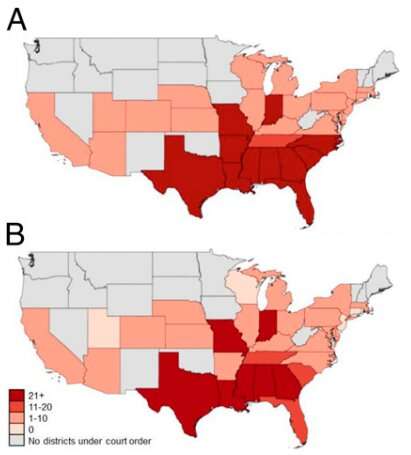School segregation harms Black children's health, well-being

Black youth who attend racially segregated schools are more likely to have behavior problems and to drink alcohol than Black youth in less segregated schools, according to a UC San Francisco study published in Pediatrics.
Black girls were more likely than Black boys to drink alcohol in response to increased school segregation.
The research provides some of the first evidence of the relationship between recent increases in school racial segregation and the well-being of Black children, said first author Guangyi Wang, Ph.D., a research analyst with the UCSF Philip R. Lee Institute for Health Policy Studies.
"Schooling can influence one's life course and attending segregated schools is commonplace for Black children, but research on its relationship to their health is scarce," said Wang.
As level of segregation increases, so do problems
The study examined data on 1,248 Black children, ages 5–17, who lived in school districts that were under court-ordered desegregation in 1991. That year, the Supreme Court issued rulings that made it easier for districts to be released from the 1954 Brown v. Board of Education decision that declared segregated schools unconstitutional. Since then, highly segregated schools with 10% or fewer white students have more than tripled, from 5.7% to 18.6%.
The researchers analyzed key measures of the children's well-being alongside districts' segregation levels through 2014. To measure segregation, they used the Black-White dissimilarity index, which indicates the proportion of Black or white students who would need to move to a different school to achieve uniform racial distribution. Values range from 0 to 1; higher values indicate a school district is more segregated.
Every 0.2 increase in the dissimilarity index was associated with a 31% increase in behavioral problems and a 62% increase in the likelihood of drinking, the researchers found.
The findings are consistent with a large body of literature linking racial, economic and social marginalization with inequities in child behavioral problems, the authors wrote. Children who are chronically exposed to stressful family and neighborhood environments may have more difficulty managing mental and emotional challenges, and stress can lead to unhealthy coping behaviors like drinking. This study showed the similarly unhealthy effects of segregated school environments, to which Black children are disproportionately exposed.
Structural racism at play
While segregated schools could plausibly improve some outcomes of well-being by reducing exposure to interpersonal racism from white peers or teachers, this effect isn't strong enough to counter structural racism, said senior author Rita Hamad, MD, Ph.D., an associate professor in residence in the UCSF Department of Family and Community Medicine.
"Any potential interpersonal benefits are likely being overpowered by the manifestations of structural racism in segregated schools," said Hamad. "For example, Black children may experience harsher disciplinary treatment at racially segregated schools as part of the 'school-to-prison pipeline.'"
More frequent police encounters are associated with poorer mental health among adolescents, especially Black girls, she noted. Simultaneously, highly segregated schools are typically less well funded. This means they have fewer resources to provide adequate support for children's mental health and cognitive development.
"All of these racism-related factors create a domino effect, pushing kids with school segregation-induced behavioral problems into a harmful cycle of racial inequities in lifetime well-being," said Hamad, who is affiliated with the UCSF Philip R. Lee Institute for Health Policy Studies and is the director of the Social Policies for Health Equity Research Program.
School integration, support needed
"With the Black-White child health gap enduring, our findings show that school integration and support for Black children who attend segregated schools may help to reduce health inequities," said Wang.
Indeed, the 1954 Supreme Court ruling that school racial segregation was unconstitutional led to substantial increases in racial integration across schools in the 1960s–1970s. This improved Black people's well-being, including increasing educational and occupational attainment and self-rated health, Hamad noted.
"Black people experienced some benefits after schools were first integrated," said Hamad. "Now that schools are segregated again, kids are missing out on the benefits of integration. We need structural interventions to address segregation and its consequences so we can ensure more Black children have a better chance at a healthier future."
More information: Guangyi Wang et al, School Racial Segregation and the Health of Black Children, Pediatrics (2022). DOI: 10.1542/peds.2021-055952
Journal information: Pediatrics
Provided by University of California, San Francisco





















